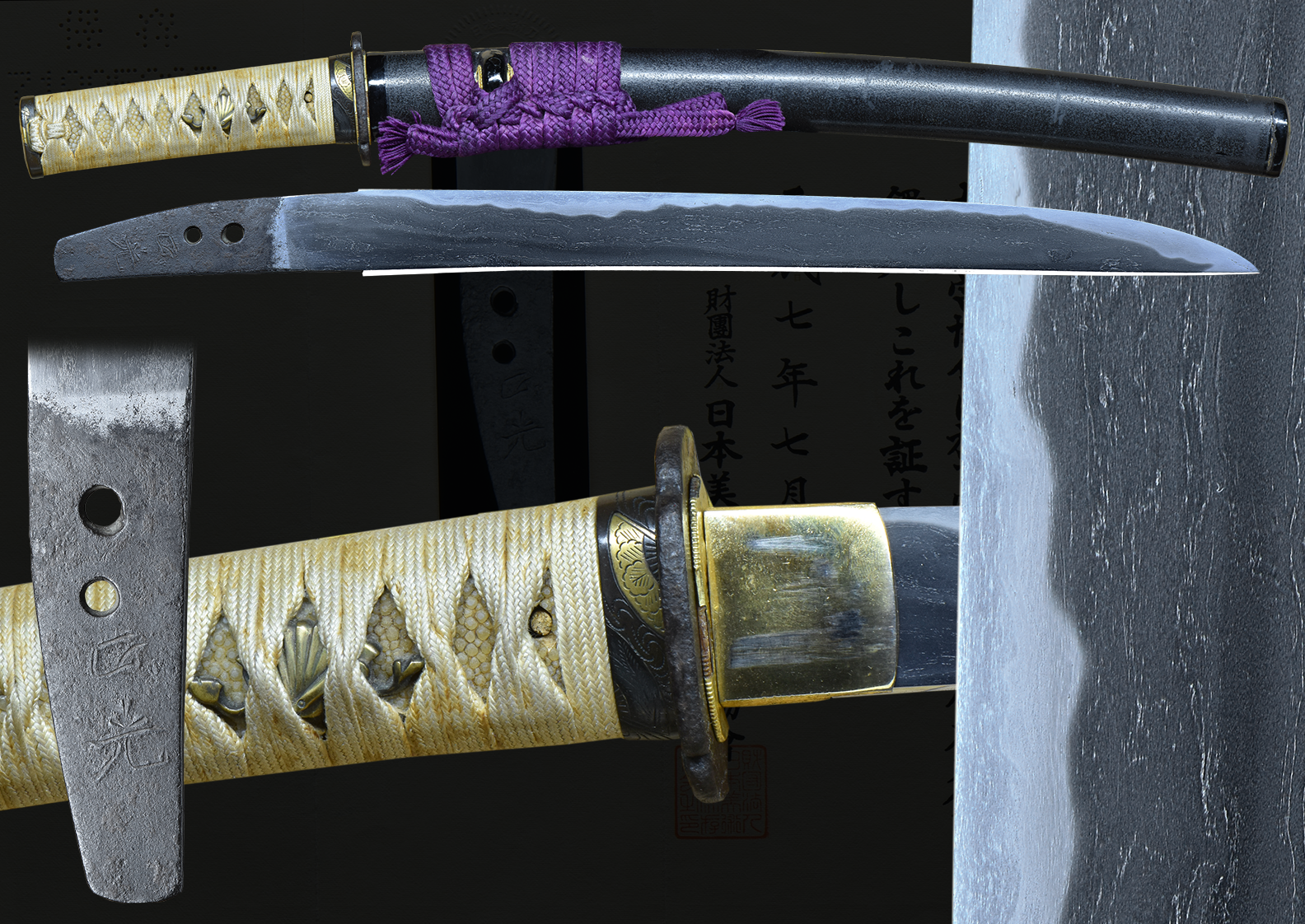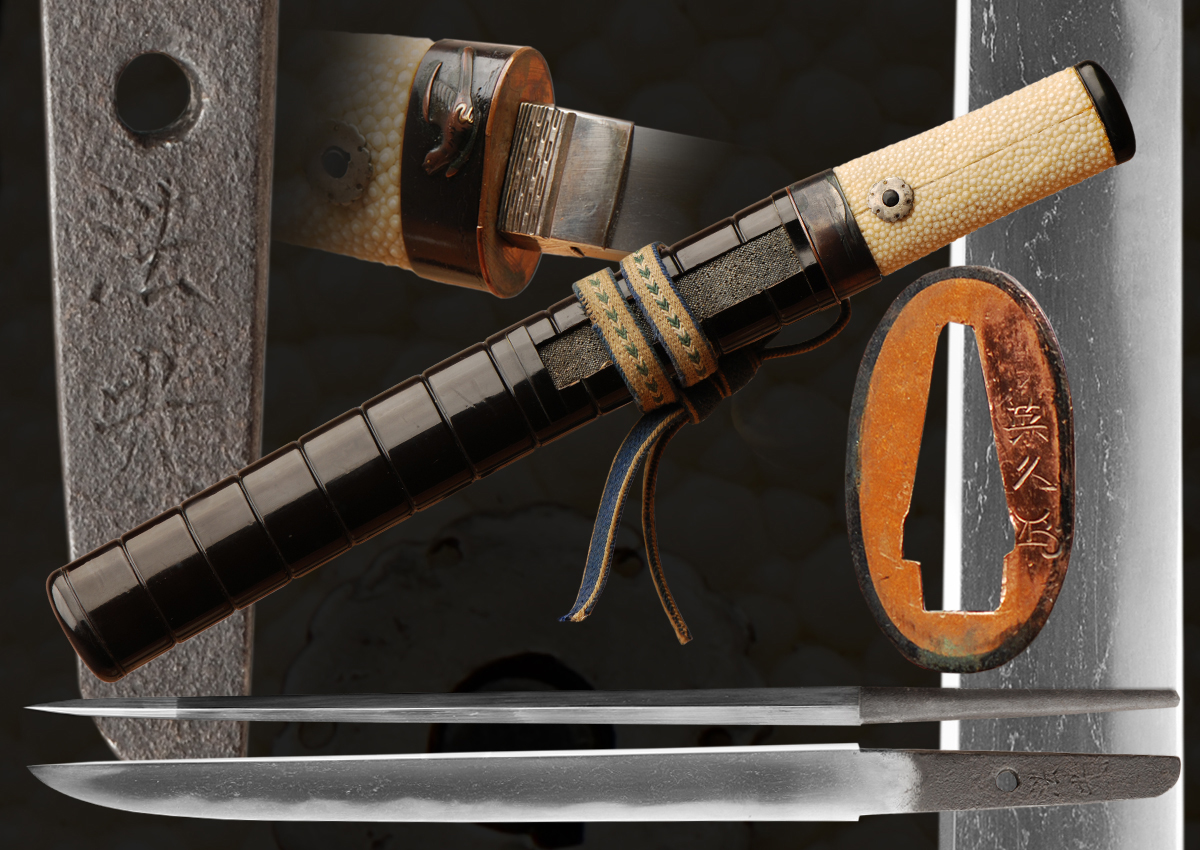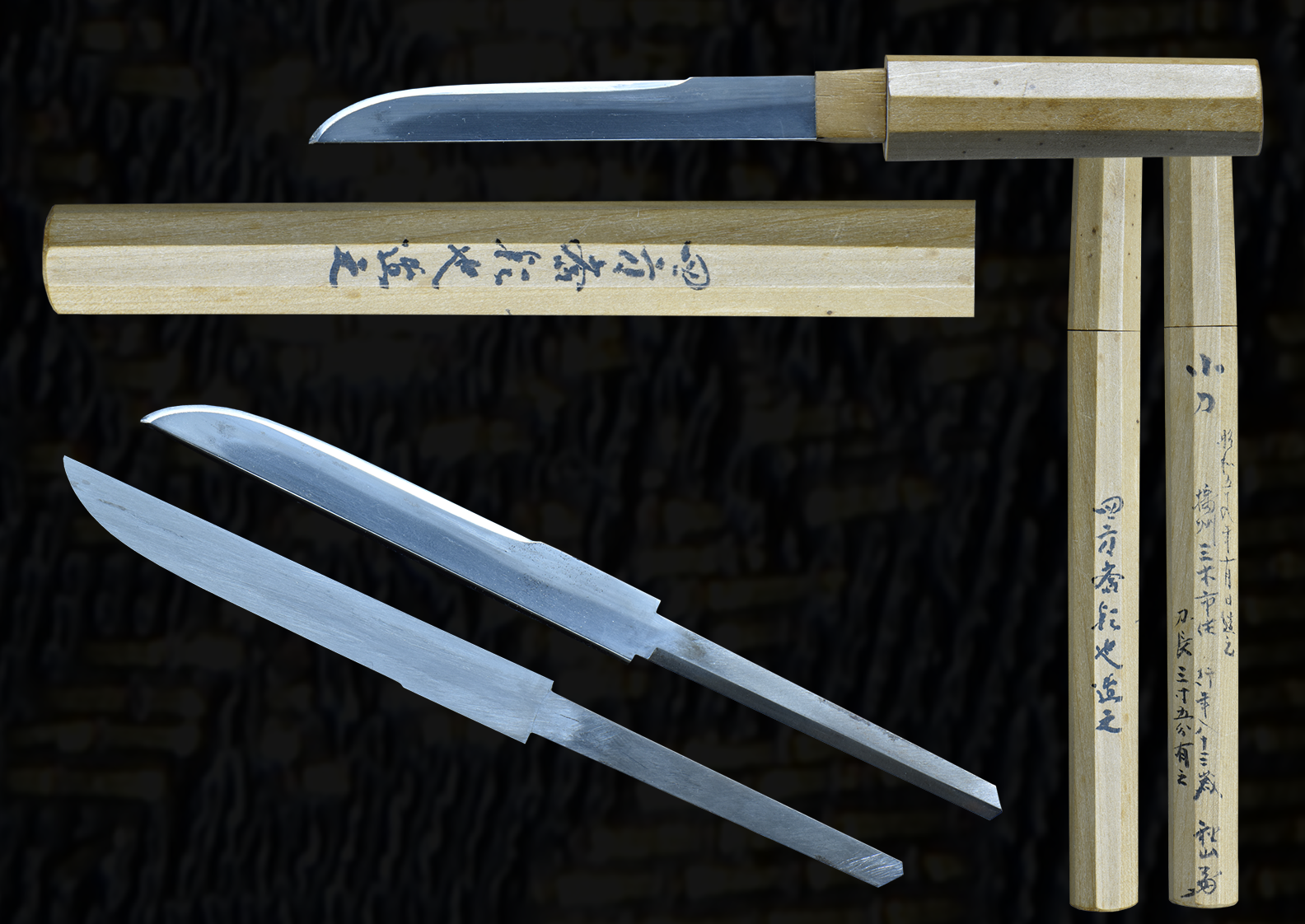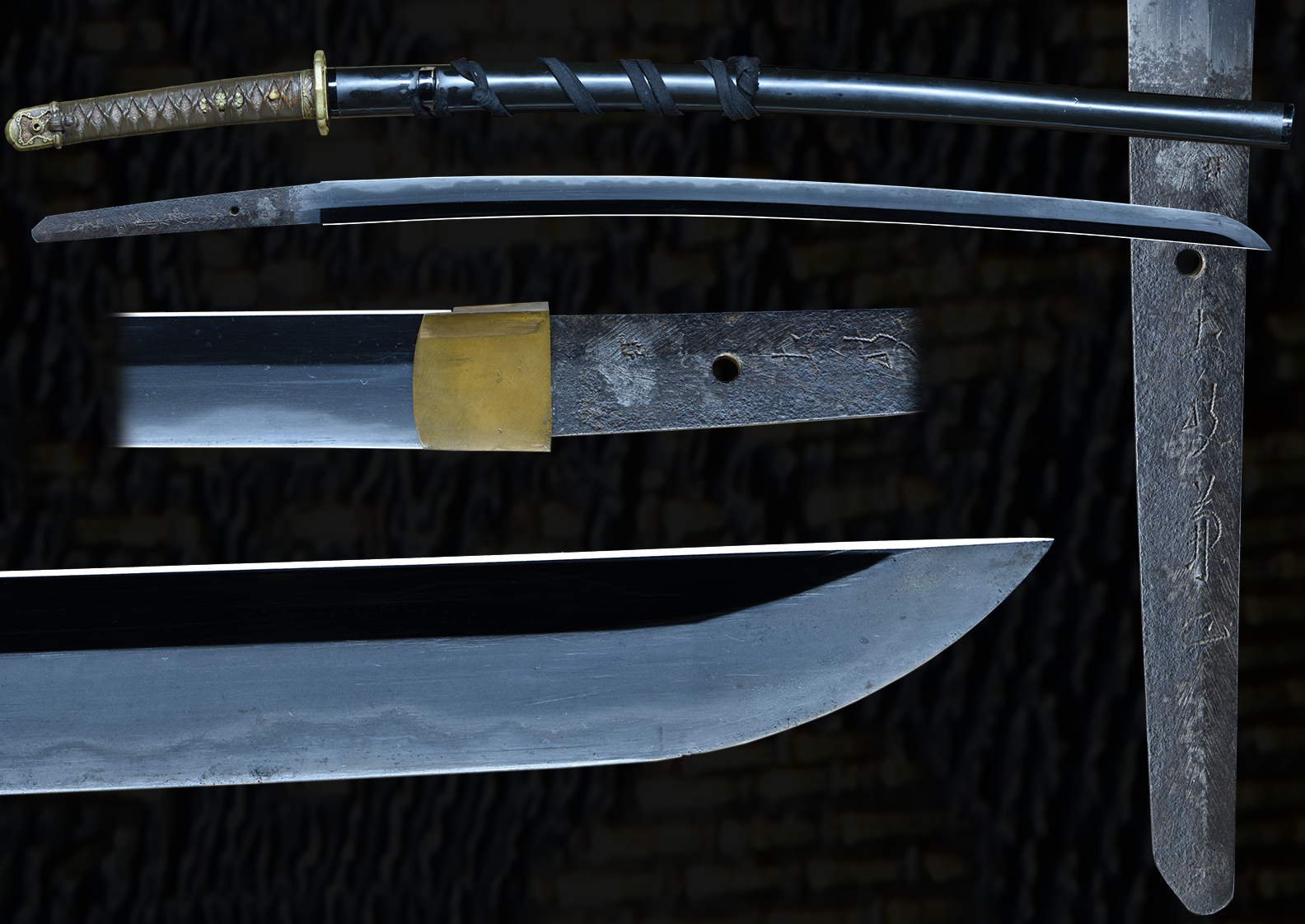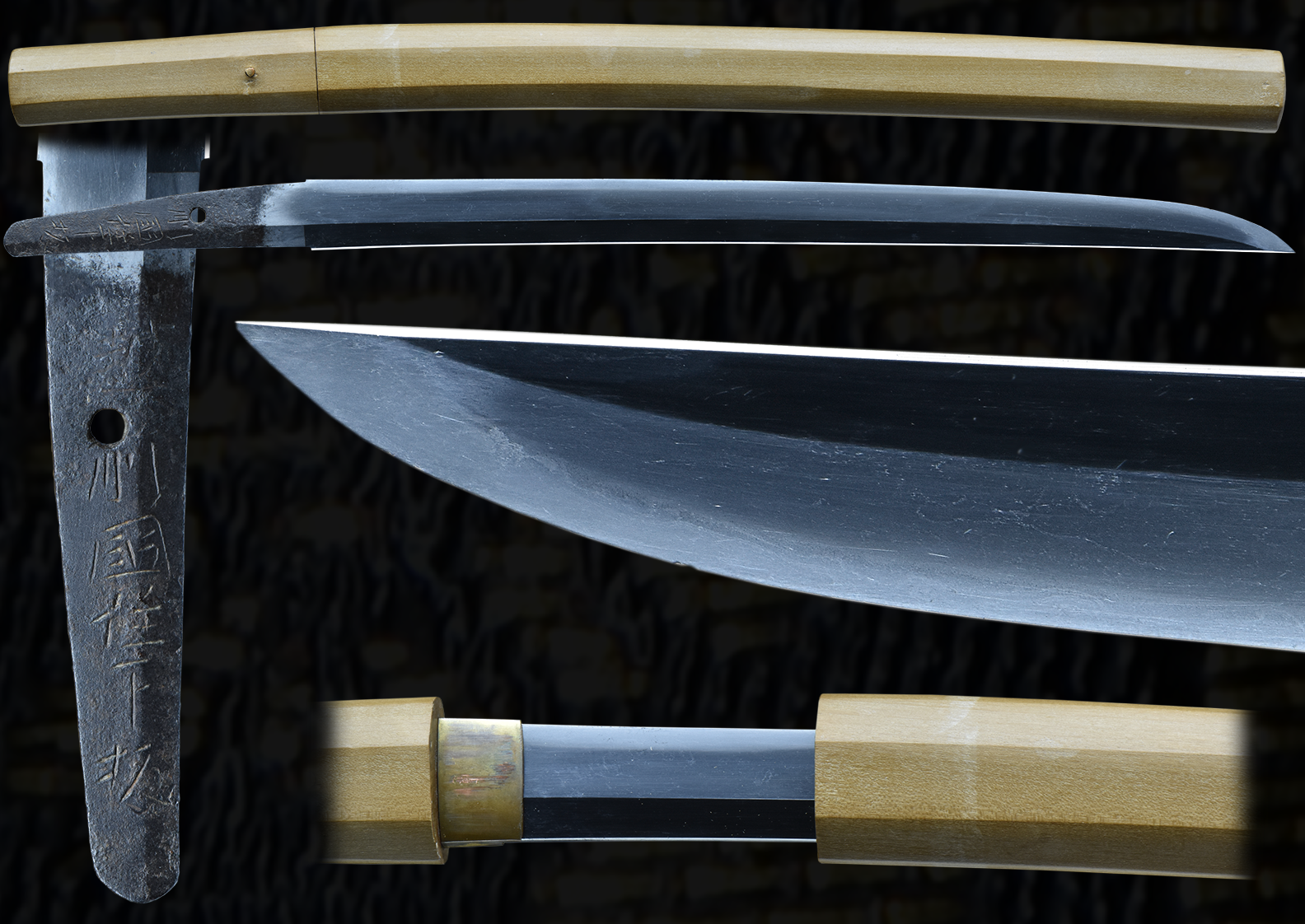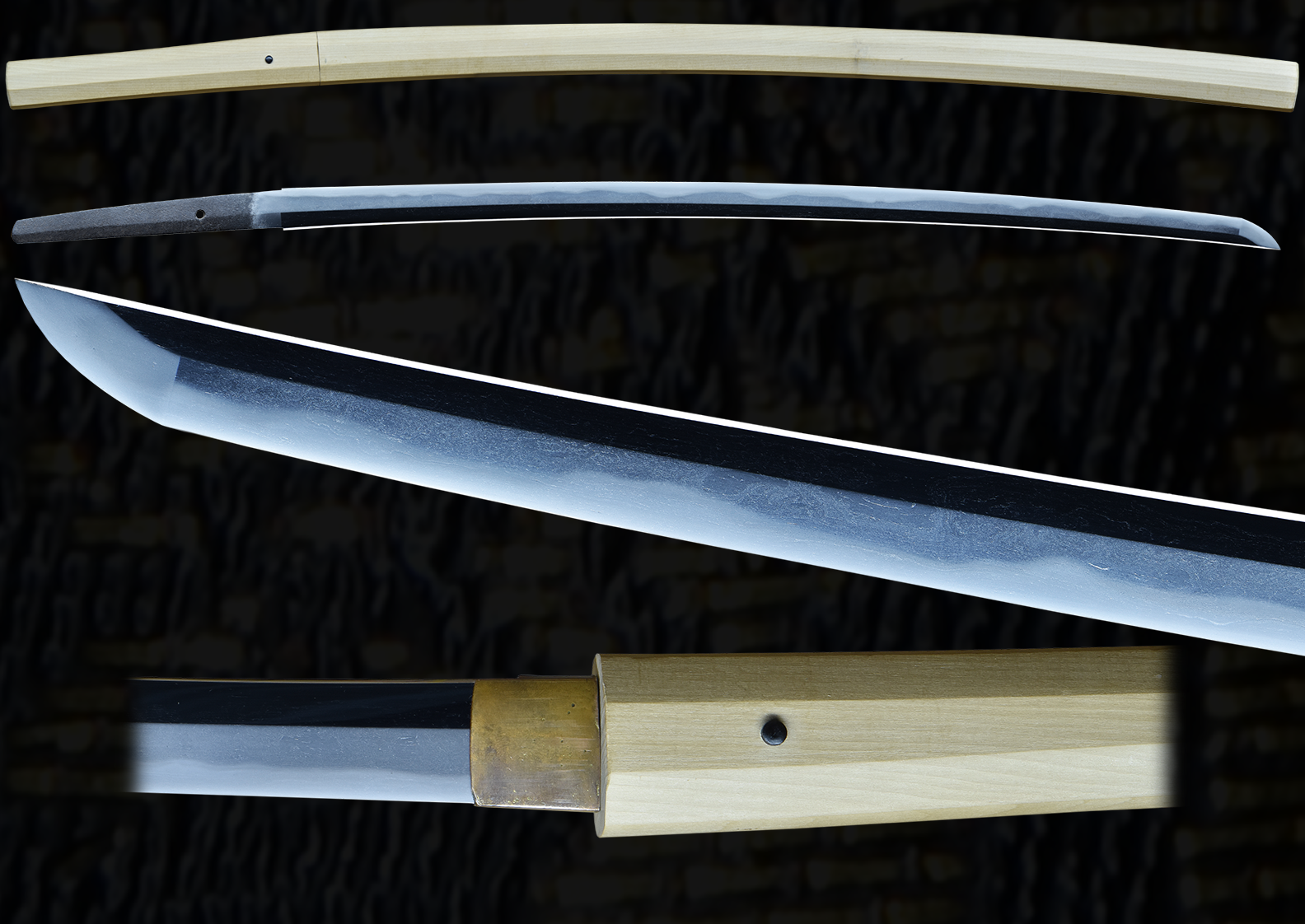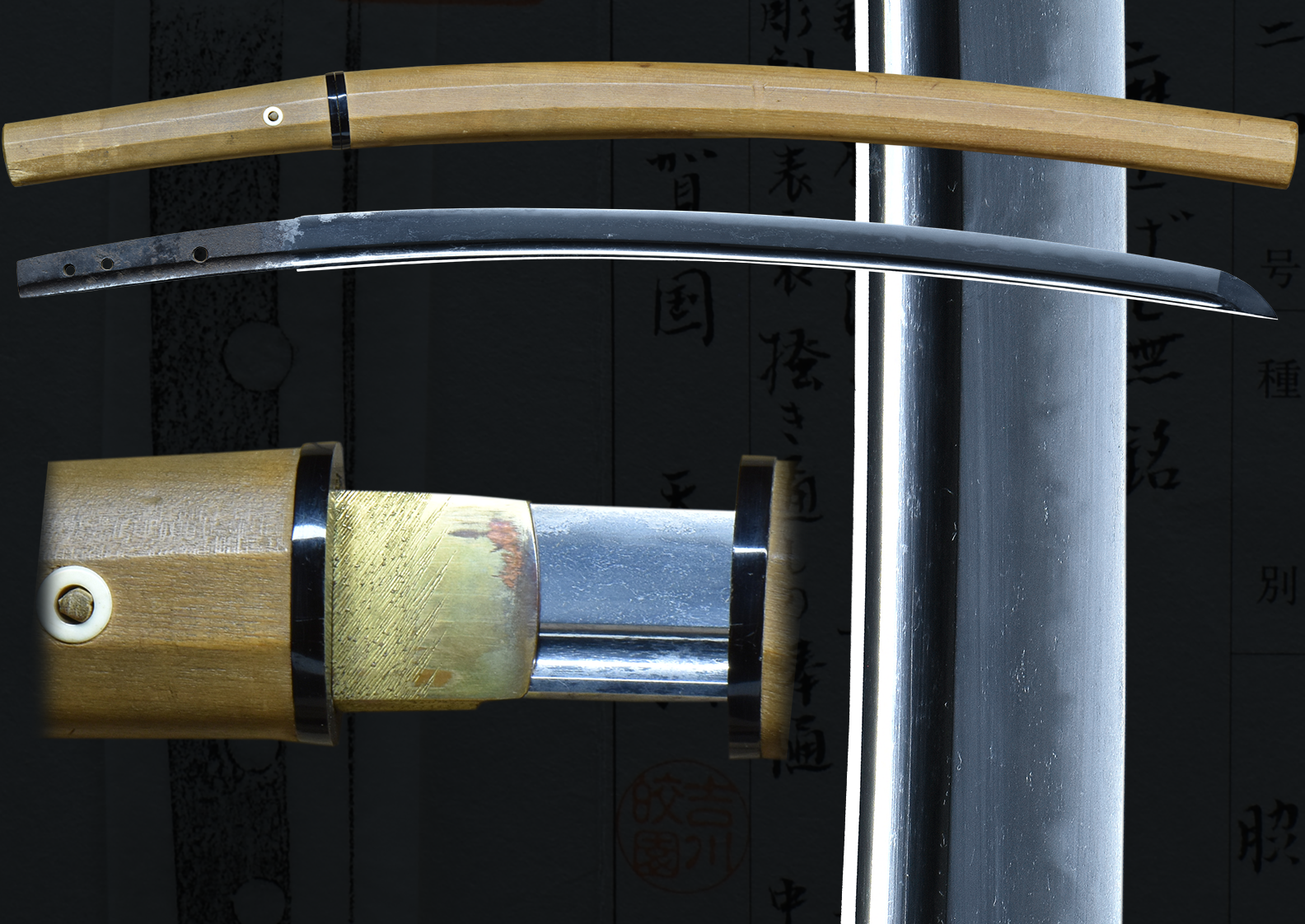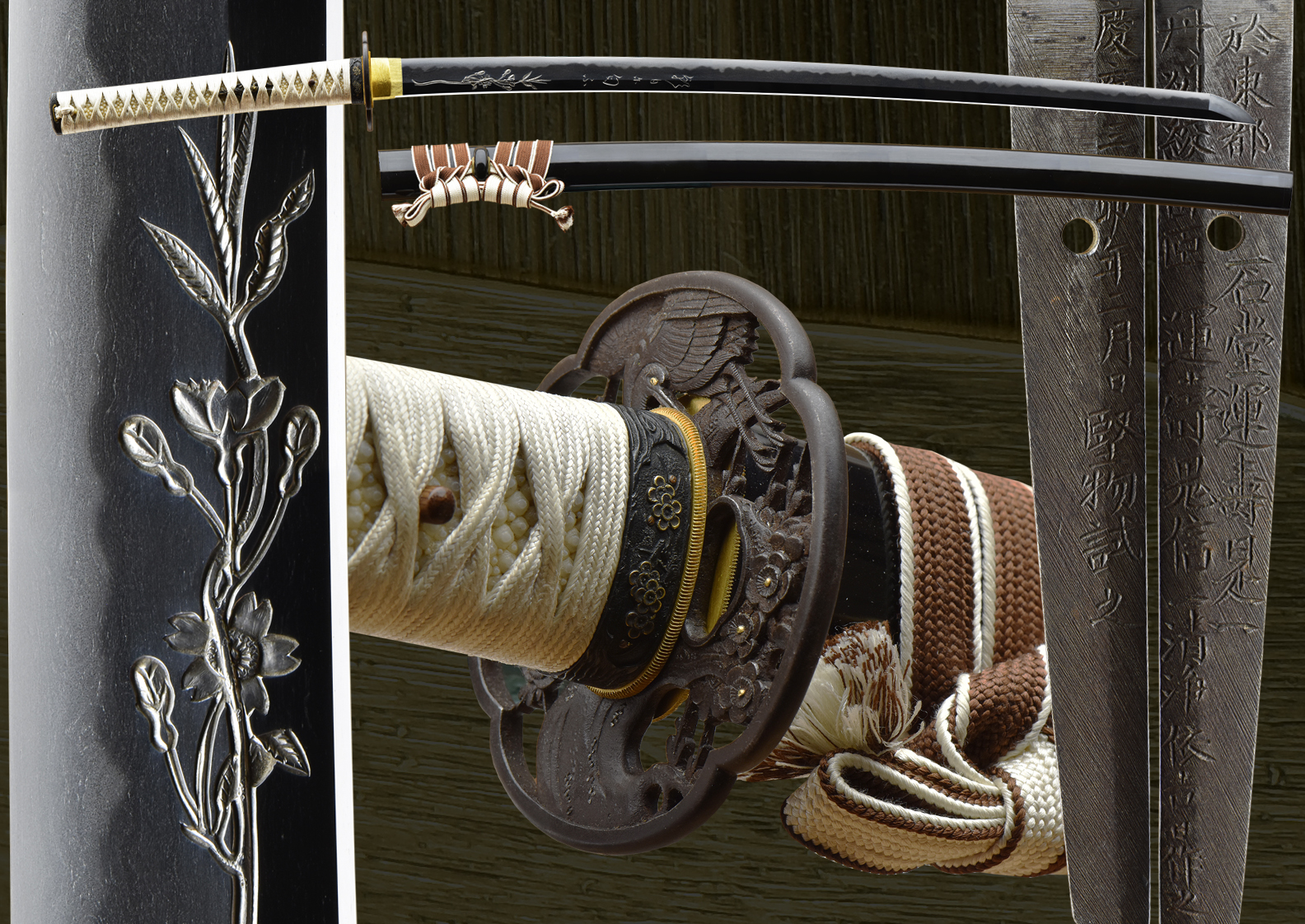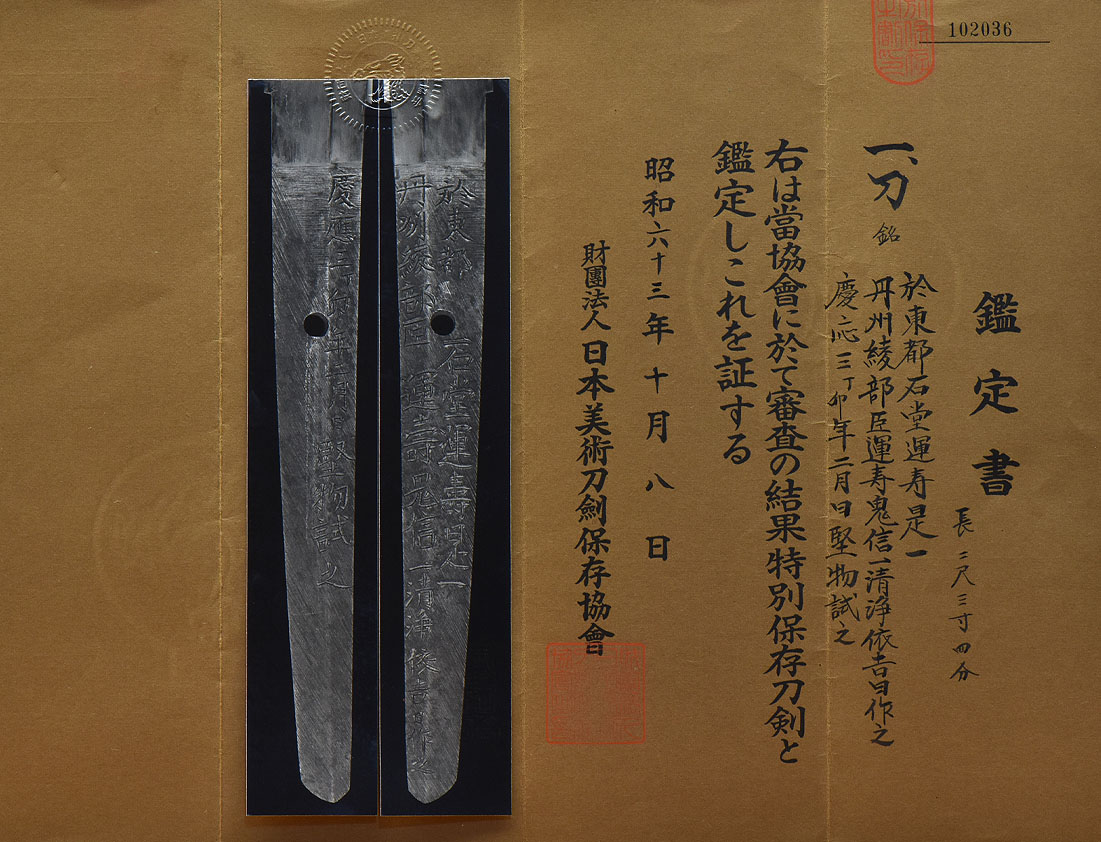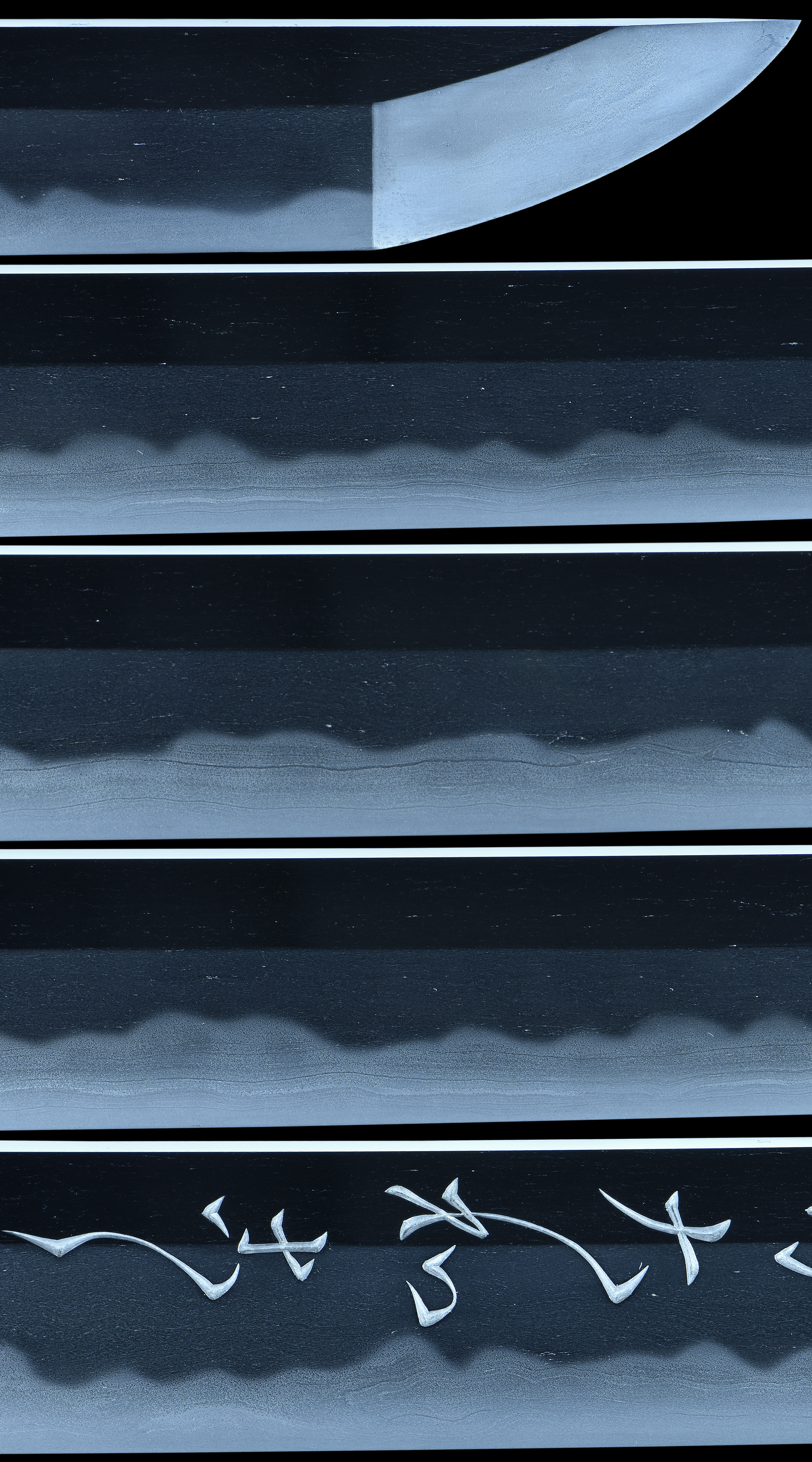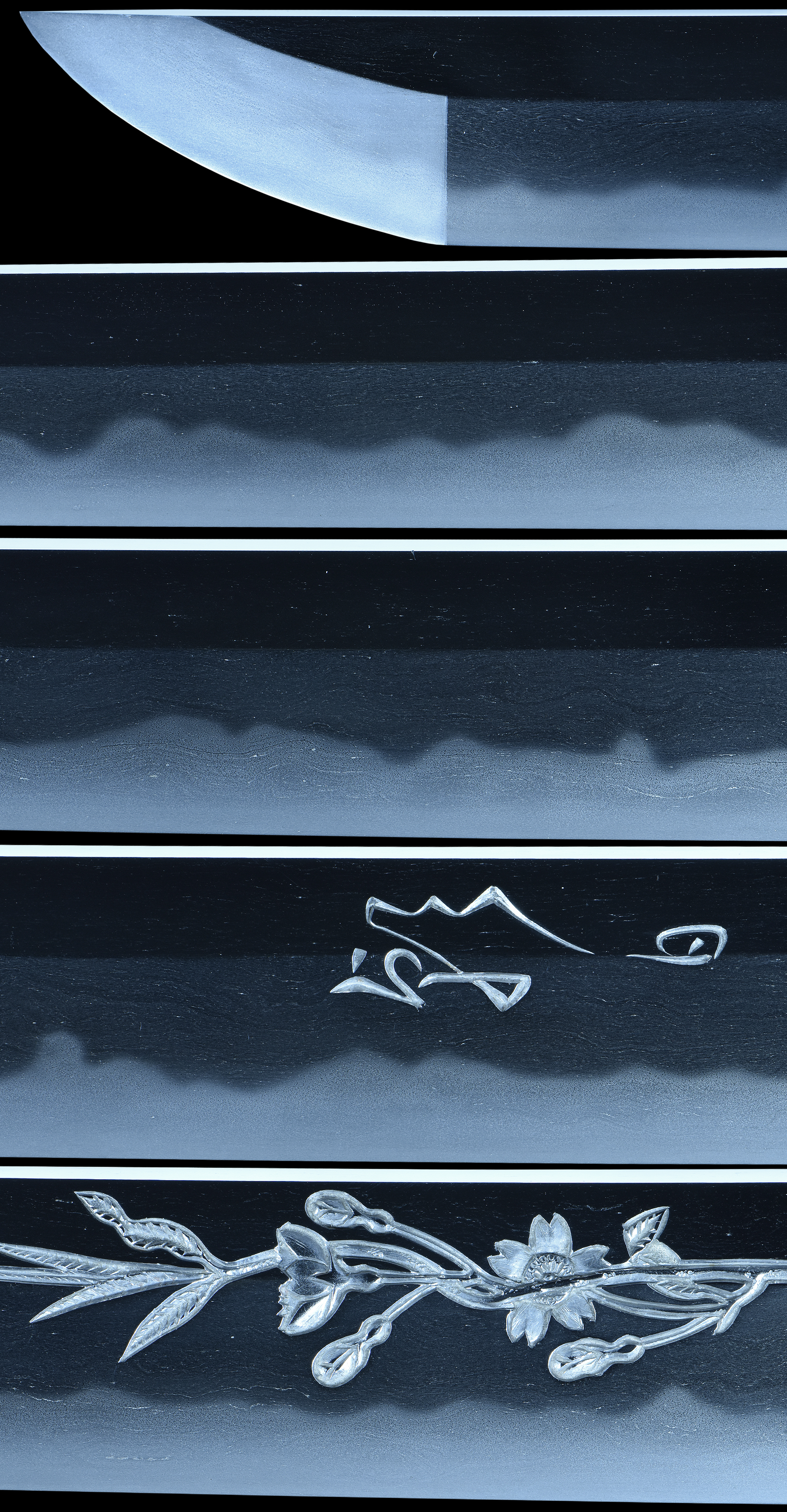Ishido Korekazu was a nephew of Kato Chounsai Tsunatoshi, He was taught and learned from him and he succeeded the Ishido family
as the seventh generation, he passed away in 1894 at the age of 75.
He made So-den bizen den style which is a combination of Bizen and Soshu den style.
The First generation Korekazu was skilled in making Bizen den style with beautiful Utsuri
but the7th generation Korekazu made swords in the Soshu style.
This sword was made on a day in the second month Keiô three (1867), year of the hare.
This sword is a combination of gunome/ choji midare within a notare blend hamon which is very rear bright and clear. The activity is amazuing and unusually clear with multitudes of hataraki such as sunagashi, kinsuji. Ko-nie and a wonderful frosting of nie can be seen on the habuchi. There are swirts of mokume as well as masame make up this eye catching hada.
There is horimono on both sides odf the blade. A masterful carving of a cherry blossom tree as well as a poem in Buddhist calligraphy and Sanskrit bonji.
The mounts keep in theme the advent of the cherry blossom. In Japan, cherry blossoms symbolize clouds due to their nature of blooming en masse, besides being an enduring metaphor for the ephemeral nature of life, an aspect of Japanese cultural tradition that is often associated with Buddhist influence,] and which is embodied in the concept mono no aware. The association of the cherry blossom with mono no aware dates back to 18th-century scholar Motoori Norinaga The transience of the blossoms, the exquisite beauty and volatility, has often been associated with mortality and graceful and readily acceptance of destiny and karma; for this reason, cherry blossoms are richly symbolic, and have been utilized often in Japanese art, and film, as well as at musical performances for ambient effect.
SPECIAL NOTE ON THE SIGNATURE:
This is how it reads:
Made in the Eastern Capital (Edo) by Ishidô Unju Korekazu.
Made on a lucky day and after the purification ritual by Unju Ki Nobukazu.
retainer of the Ayabe family from Tanba province.
On a day in the second month Keiô three (1867), year of the hare.
Tested on a hard object.
This is a very interesting signature with a cutting test!
This is a beautiful sword with a lot of attention given to details. The sword was made by a very highly rated Smith. The two highest ratings are Sai-jo saku and Jo-jo saku, this smith is rated as Jo-jo saku. Even to an untrained eye the quality of this sword stands out!
Many years ago this sword was taken to Japan for its papers by John Yamoto (author of ‘The Japanese sword”) for Mr. D. Douberly. The sayagaki is not signed but believed to be done by Yamoto-san himself. It was purchased later on by a well known collector and is being offered now for the first time in many years.
- Mei: Tôto ni oite Ishidô Unju Korekazu (於東都石堂運寿是一)
Tanshû Ayabe-shin Unju Ki Nobukazu shôjôe kichijitsu kore o saku
(丹州綾部臣運寿鬼信一清浄依吉日作之)
Keiô san hinoto-usagidoshi nigatsu hi (慶応三丁卯年二月日)
Translation:
katana, signed: Made in the Eastern Capital (Edo) by Ishidô Unju Korekazu.Made on a lucky day and after the purification ritual by Unju Ki Nobukazu.
retainer of the Ayabe family from Tanba province.
On a day in the second month Keiô three (1867), year of the hare.
Tested on a hard object. - Nagasa: 27-7/8 inches
- Sori: 10.5 mm
- Width at the ha-machi: 32.1 mm
- Width at the yokote: 22.2 mm
- Thickness at the mune-machi: 9.1 mm
- Construction: Shinogi zukuri
- Mune: Iori
- Nakago: Ubu
- Kitae: Itame/mokume
- Hamon: Midare Gunome
- Boshi: Maru
- Condition: Good polish
Click to Enlarge Image
KOREKAZU (是一), 7th gen., Ansei (安政, 1854-1860), Musashi – “Shichidai-me Ishidō Korekazu saku” (七代目石堂是一作, “made by the 7th gen. Ishidō Korekazu”), “Fujiwara Korekazu” (藤原是一), “Korekazu saku” (是一作), “Ishidō Fujiwara Korekazu kore o saku” (石堂藤原是一作之), “Ishidō Unjusai Korekazu” (石堂運寿斎是一), “Ryūsensai Ishidō Korekazu” (龍泉斎石堂是一), “Ishidō Unju Korekazu seitan kore o tsukuru” (石堂運寿是一精鍛造之, “carefully forged by Ishidō Unju Korekazu”), real name Kawakami Seitarō (川上政太郎, the first name also reads Masatarō), he also bore the first name Sukezaburō (助三郎), he was born on the 24th day of the first month Bunsei three (文政, 1820) as second son of Chōunsai Tsunatoshi (長運斎綱俊), another tradition says that he was the nephew of Tsunatoshi, later he was adopted by the 6th gen. Korekazu and took over the family in the twelfth month of the twelfth year of Tenpō (天保, 1841), he lived in Kita-Shinmonzen (北新門前) in Edo´s Azabu district (麻布), first he used the gō Unjusai (運寿斎) but changed in the second year of Meiji (1869) to Ryūsensai (龍泉斎), he died on the 24th day of the eleventh month Meiji 24 (1891) at the age of 72, the 7th gen. Korekazu became famous for reviving the Ishidō-Bizen style and he trained many students, he also forged blades for the Ise Shrine and the Edo city magistrate Tōyama Saemon no Jō Kagemoto (遠山左衛門尉景元, 1793-1855), his blades have a rather shallow sori, a relative high shinogi, a narrow shinogi-ji, and a somewhat larger kissaki, the jigane is a dense ko-mokume which tends to muji, also a ko-mokume mixed with ō-hada and sometimes also a chikei-laden jihada in the style of Kiyomaro (清麿) is found, in his early years he applied a chōji-midare with compact nioiguchi similar to Tsunatoshi, later he changed to a chōji-midare with plenty of ko-nie and many hataraki, sometimes he also worked in the Sōshū tradition, the bōshi is ko-maru or midare-komi, at blades in Sōshū tradition we find a midare-komi with hakikake and much nie, some works show elaborate horimono, the stout but carefully finished tang has a kurijiri, sometimes also a kijimono-gata is found, the yasurime are ō-sujikai with keshō whereas every file stroke was added by its own, the shōgun granted him the permission to carve an Aoi crest to his tangs, we know blades which were made by using magnetic iron ore (beitetsu or mochitetsu, 餅鉄) from Morioka (盛岡), magnetic iron ore is found in spherical shape for example in rivers and was used since oldest times for sword forging, jōjō-saku
Follow this link for interesting history on the Korekazu family.
Click to Enlarge Image
Click to Enlarge Image
Horimono:
The carving on this sword is of wild cherry blossoms and the writing is a poem. This is the translation.
敷島乃大和古々ろ越人問ハ々 朝日爾匂ふ「山桜」
Shikishima no Yamato-gokoro o hito towaba, asahi ni niou yamazakura.
“If one asks about the soul of Japan, I would say that it is like wild cherry blossoms glowing in the morning sun.” – Motoori Norinaga (本居宣⻑, 1730-1801)
Note:
The last two characters in the poem, yamazakura (“wild cherry blossoms”), are not written out but represented by an actual engraving of the flower in rebus style.
Click to Enlarge Image
kantei-sho (鑑定書) No 102036
katana, mei:
Tôto ni oite Ishidô Unju Korekazu (於東都石堂運寿是一)
Tanshû Ayabe-shin Unju Ki Nobukazu shôjôe kichijitsu kore o saku
(丹州綾部臣運寿鬼信一清浄依吉日作之)
Keiô san hinoto-usagidoshi nigatsu hi (慶応三丁卯年二月日)
Katamoto kore o tamesu (堅物試之)
nagasa 2 shaku 3 sun 4 bu
Migi wa tô-kyôkai ni oite shinsa no kekka, tokubetsu-hozon-tôken to kantei-shi kore o shô-suru.
(右は當協會に於て審査の結果特別保存刀剣と鑑定しこれを証する)
Shôwa rokujûsannen jûgatsu yôka (昭和六十三年十月八日)
zaidan-hôjin (財團法人): Nihon Bijutsu Tôken Hozon Kyôkai (日本美術刀劍保存協會)
Appraisal
katana, signed: Made in the Eastern Capital (Edo) by Ishidô Unju Korekazu.
Made on a lucky day and after the purification ritual by Unju Ki Nobukazu.
retainer of the Ayabe family from Tanba province.
On a day in the second month Keiô three (1867), year of the hare.
Tested on a hard object.
nagasa ~ 70.9 cm.
According to the result of the shinsa committee of our society we judged this work as authentic and designate it as tokubetsu-hozon-t
October 8, 1988
[Foundation] NBTHK
SAYAGAKI
御刀
慶応三丁卯年二月日堅物試之
於東都石堂運寿是一
丹州綾部臣運寿鬼信一清浄依吉日作之
刃長サ貮尺参寸之有
O-katana
Keiô san hinoto-usagidoshi nigatsu hi
Tôto ni oite Ishidô Unju Korekazu
Tanshû Ayabe-shin Unju Ki Nobukazu shôjôe kichijitsu kore o saku
Nagasa 2 shaku 3 sun kore ari
Katana
On a day in the second month Keiô three (1867), year of the hare. Tested on a hard object.
Made in the Eastern Capital (Edo) by Ishidô Unju Korekazu.
Made on a lucky day and after the purification ritual by Unju Ki Nobukazu, retainer of the Ayabe family from Tanba province.
Blade length ~ 69.7 cm [by not explicitly adding the bu measure, this is the nagasa that calculates from just 2 shaku 3 sun]
Asking price: $29,600.00
(shipping and insurance included)
Email us if your interested in this item and remember to include the order number for this item: fss-850.
Click to Enlarge Image
Click to Enlarge Image
Click to Enlarge Image
For Sale
